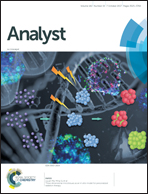Understanding the responses of Saccharomyces cerevisiae yeast strain during dehydration processes using synchrotron infrared spectroscopy
Abstract
For the first time, synchrotron infrared spectroscopy was performed on yeast during dehydration processes in real time with simultaneously controlled relative humidity and temperature. This led us to investigate the biochemical modification in relation to the dehydration of Saccharomyces cerevisiae. The correlation between the hydration level and yeast survival was observed. Following the test conditions, the modification of the protein structure was observed. However, no evident modification of the lipid composition resulting from dehydration was observed. Furthermore, the results showed that the medium rich in nutrients and glutathione precursors can improve yeast survival during dehydration at 45 °C. This could be related to the high relative amounts of CH3 groups in the lipid composition assigned to the low lipid oxidation level in this case. Our work demonstrated the feasibility of using S-FTIR for investigating yeast responses to dehydration processes in real time. This method can be used for understanding the effect of dehydration/rehydration on the biochemical modification of yeast.



 Please wait while we load your content...
Please wait while we load your content...